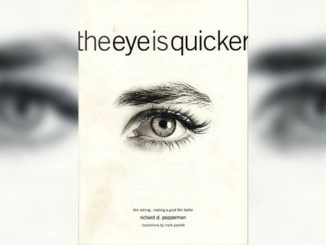
by Bruce Karder
My interests in film and theatre started at Roy Elementary School in Northlake, Illinois, when I got to do lighting for school plays. I became a member of the Audio Visual (AV) club and operated the projectors and tape recorders used in classes. Upon entering high school, I did not mend my ways — staying active in drama, stage productions and AV for all four years. At Purdue University, I majored in theatre and electrical engineering with the intention of going into theatrical lighting design.
After my freshman year in June 1956, I landed a paying job at WTTW-TV (Chicago’s educational station) as a kinescope editor for $70 a week, thanks to my AV instructor. Kinescopes were 16mm black- and-white film photographed off a special TV tube, then processed as normal film; videotape hadn’t been developed yet. After three months, I resigned to return to school, but they offered me a promotion to department head with two employees under me and a $3-a-week raise! I said, “Yes.” Since I wouldn’t be going back to Purdue, I started night school and simultaneously became a member of IATSE Local 780 — the Chicago local for film editors and laboratory technicians. In the mid 1980s, Local 780 dissolved and the members became members of Local 776.
In public television there is always a lack of funds. After a year, I got laid off. I had just turned 20 and the union offered me an apprenticeship program. From spring of 1957 to March of 1958, I held seven different jobs and never got fired, contracting to work from two weeks to three months. My employers included two different production houses as an assistant editor, CBS network as a news editor, and several labs as editor, inspector, negative conformer and film processor. During this time I also learned to work with nitrate film (the standard film base into the mid-1950s), but it was highly flammable and explosive; it had to be stored in wet vaults. Kodak replaced it with safety film in the 1950s.
After that, the union sent me on another gig that could last as long as six months covering vacations as a film re-editor. Ironically, throughout my entire apprenticeship program, I never held the title “apprentice.”
I was enjoying my time working in television until I got a greeting from Uncle Sam — I was drafted! This was between the Korean and the Vietnam Wars, and I enlisted in the Air Force. While in basic training, I took written exams for assistant film editor and assistant cameraman. I must have done well because I was assigned to the 1365th Photo Group, Orlando, Florida. My civilian boss, Ken Skelton, had been head of Warner Bros.’ sound division in 1941 and was among the many Hollywood types who founded the Armed Forces Motion Picture Service. Skelton became my mentor. I was assigned to be a sound effects editor on all classified productions and training films, and I learned to service and maintain Moviola machines.
Fourteen months later, I was transferred from Florida to Alaska, where our job was to provide four movies a week to isolated military sites. Later I was sent to Macon, Georgia, to manage a film library — a job for which I was never trained, but I managed to fool them for over a year.
Returning from the Air Force in 1963, thanks to the Uniformed Services Employment and Re-employment Rights Act, my job at WLS-TV ABC Channel 7 was waiting for me if I wanted it. They were just starting a news department and, with the help of my military film experience/training, I was given the opportunity to be a news editor.
In 1966, I won my first Emmy Award for The Ireland 5 — the story of a university basketball team. It’s noteworthy that the world of TV news was quite a different world from studio (series) editing; we never had the luxury of work prints — we cut original negative! When I edited a program called A Weekend with the Blind, my producer and I worked at a production house rather than in the news department. The other editors at the production house almost had heart attacks when they saw us cutting original negative and treating it like work print — but that was what we were used to! We received an Emmy nomination for that project. I was lucky enough to receive a second Emmy in the Breaking News category for Tornado, and a Clarion Award for a series called Supper Rats.
I retired in March 2001 with a 45-year IA Gold Card. In my 38 years of editing news, I got to work on every major story that ever happened in Chicago. I loved my work and news editing gave me a good life. But retirement, traveling and my grandchildren are even better!





